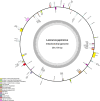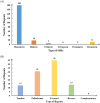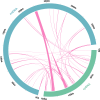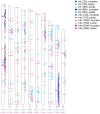Unraveling the mitochondrial genome of the medicinal Chinese motherwort (Leonurus japonicus, Lamiaceae): structural dynamics, organelle-to-nuclear gene transfer, and evolutionary implications
- PMID: 40530293
- PMCID: PMC12170669
- DOI: 10.3389/fpls.2025.1546449
Unraveling the mitochondrial genome of the medicinal Chinese motherwort (Leonurus japonicus, Lamiaceae): structural dynamics, organelle-to-nuclear gene transfer, and evolutionary implications
Abstract
Introduction: Leonurus japonicus (Chinese motherwort) is a medicinal Lamiaceae species renowned for its pharmacological compounds, yet its mitochondrial genome remains unexplored. Elucidating mitogenomic structure and evolution can inform plant genetics, phylogenetics, and molecular breeding.
Methods: We assembled the complete mitochondrial genome of L. japonicus using a combination of Oxford Nanopore long reads and Illumina short reads. Three assembly strategies-de novo assembly with PMAT and Flye, and hybrid assembly with Unicycler-were integrated and validated via read mapping and comparison to reference mitogenomes (Salvia miltiorrhiza, Arabidopsis thaliana, Liriodendron tulipifera). Annotation employed GeSeq, tRNAscan-SE, and manual curation. Repeat elements (SSR, tandem, dispersed) were identified with MISA, TRF, and REPuter; plastid-to-mitochondrion transfers (MTPTs) were detected by BLASTN against the assembled plastome; and RNA editing sites were predicted using Deepred-mt. Phylogenetic and synteny analyses were conducted with IQ-TREE, MAFFT alignments of 24 conserved PCGs, and NGenomeSyn visualization.
Results: The circular mitogenome spanned 384,199 bp (45.1% GC) and encoded 35 protein-coding genes, 11 tRNAs, and 3 rRNAs. We detected 241 SSRs, 13 tandem repeats, and 90 dispersed repeats, indicating extensive recombination potential. Thirty-one MTPTs totaling 24,818 bp (6.46% of the mitogenome) were identified. Comparative analyses revealed strong purifying selection (Ka/Ks < 1) across most PCGs, with selective signatures in atp4 and ccmB. Phylogenetic inference placed L. japonicus among Lamiales, closely allied to Scutellaria tsinyunensis and Rotheca serrata. Synteny maps demonstrated frequent genome rearrangements. Deepred-mt predicted 408 C-to-U RNA editing sites, notably in nad4 and ccmB, including novel start and stop codons.
Discussion: The L. japonicus mitogenome exhibits marked structural plasticity, reflecting dynamic repeats and organelle-to-organelle DNA transfers. Extensive RNA editing underscores post-transcriptional regulation in mitochondrial function. These findings enrich genomic resources for Leonurus, support phylogenetic and evolutionary studies in Lamiaceae, and lay groundwork for molecular breeding and conservation strategies targeting mitochondrial traits.
Keywords: Leonurus japonicus; RNA editing; long-read sequencing; mitochondrial genome; phylogenetic relationships; plastid-derived DNA; repeat sequence; synteny analysis.
Copyright © 2025 Bai, Zhu, Chen, Wang, Liu, Feng, Huang, Lee, Kokubugata, Qi and Yan.
Conflict of interest statement
The authors declare that the research was conducted in the absence of any commercial or financial relationships that could be construed as a potential conflict of interest.
Figures








Similar articles
-
Decoding the complete mitochondrial genome of Hydrangea chinensis maxim.: insights into genomic recombination, gene transfer, and RNA editing dynamics.BMC Plant Biol. 2025 Aug 16;25(1):1078. doi: 10.1186/s12870-025-07119-z. BMC Plant Biol. 2025. PMID: 40817245 Free PMC article.
-
Characterization and comparative analysis of the complete mitochondrial genome of Phlomoides rotata, a traditional Tibetan medicinal plant.BMC Genomics. 2025 Aug 6;26(1):727. doi: 10.1186/s12864-025-11871-9. BMC Genomics. 2025. PMID: 40770612 Free PMC article.
-
Complete sequencing of the mitochondrial genome of tea plant Camellia sinensis cv. 'Baihaozao': multichromosomal structure, phylogenetic relationships, and adaptive evolutionary analysis.Front Plant Sci. 2025 Jun 13;16:1604404. doi: 10.3389/fpls.2025.1604404. eCollection 2025. Front Plant Sci. 2025. PMID: 40584852 Free PMC article.
-
Advance in the assembly of the plant mitochondrial genomes using high-throughput DNA sequencing data of total cellular DNAs.Plant Biotechnol J. 2025 Jul 29. doi: 10.1111/pbi.70249. Online ahead of print. Plant Biotechnol J. 2025. PMID: 40729494 Review.
-
A meta-analysis of genome-wide association studies to identify candidate genes associated with feed efficiency traits in pigs.J Anim Sci. 2025 Jan 4;103:skaf010. doi: 10.1093/jas/skaf010. J Anim Sci. 2025. PMID: 39847436 Free PMC article.
References
LinkOut - more resources
Full Text Sources
Miscellaneous

